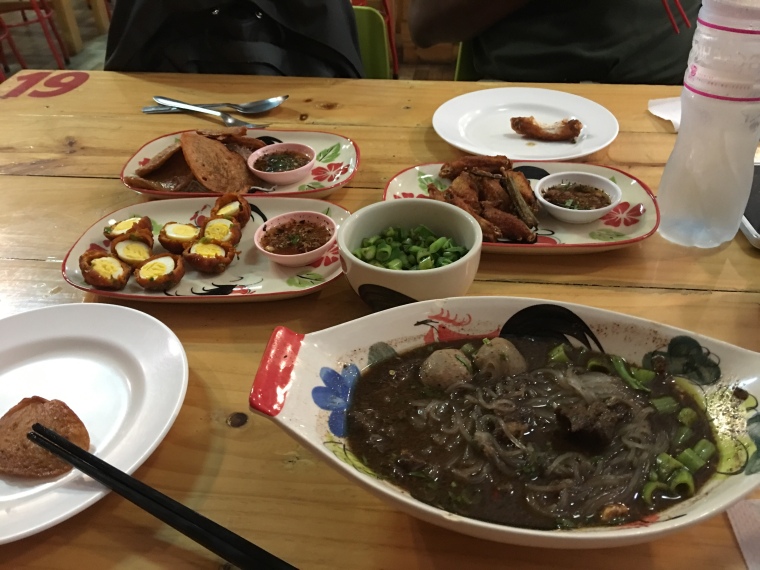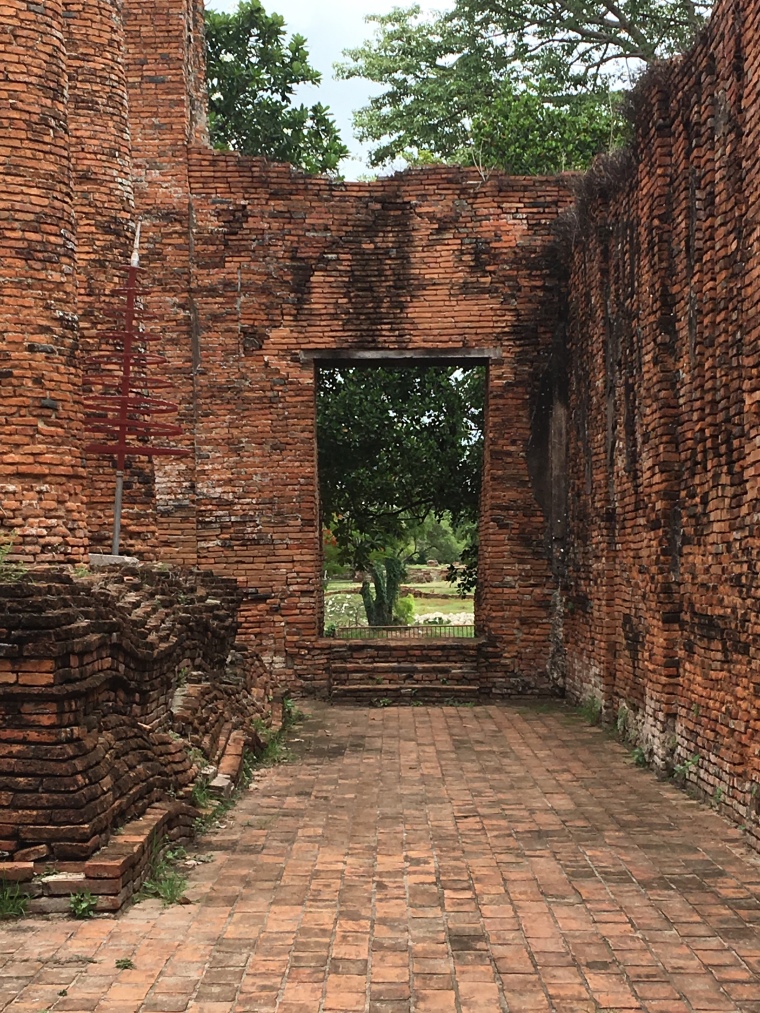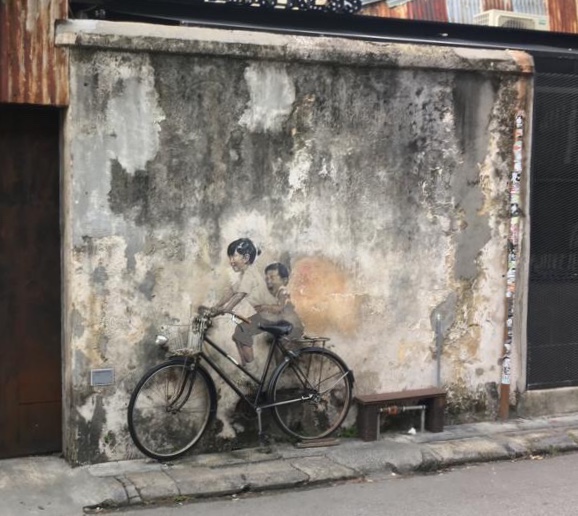
Two months ago, we left Washington, DC on the first leg of our 24+ hour travel to Bangkok. Based on advice from many sources, we keep our first stay in Bangkok to 3 days – long enough to decompress from our travel, catch up on our sleep and begin to marvel at the strangeness of our new surroundings. We knew we would travel back though Bangkok again and so we keep our touring to a minimum and spent most of the 3 days just trying to acclimate.
Now that we are a third of the way into our time here in Southeast Asia, it is time to share some reflections and thoughts with you about our time here and the style of travel we’ve embraced along this trip. So, in no particular order or rhyme or reason, here goes —
Status Update
Since leaving Panama, we have been traveling for 73 days, visited 20 places and traveled 17,368 miles. As the map shows, we traveled from Panama to the US and then to Bangkok (via Atlanta and Amsterdam). From Bangkok, we flew to Bali where we split our time between Ubud and Seminyak before flying to Surabaya on the Indonesian island of Java. From Surabaya, we traveled by train across Java, spending time in Yogyakarta, Bandung and Jakarta after which we flew to Singapore, followed by Kuala Lumpur and Penang in Malaysia. We then returned to Thailand, visiting Phuket and Bangkok and are currently in Chiang Mai in northern Thailand.


We left on this trip with an outline of places we wanted to visit based on our research and as we did when traveling with Wolfie through the US into Central America, we collect advice and recommendations along the way. Because we not driving ourselves and are at the mercy of public forms of transportation, we’ve had to modify travel from time to time because one mode or another proves difficult or cumbersome. So far, we have traveled by plane and train. Soon, we will add bus from Chiang Mai to Chiang Rai, Thailand and we will splurge on a river cruise by slow boat on the Mekong from the border of Thailand to Luang Prabang, Laos. Within towns and cities, we have used local taxis, Grab cars and taxis (the local version of Uber), tourist tour boats, Hop-On-Hop-Off bus tours, tuk tuks, moto-rickshaw type vehicles and minivans and motorbikes.
Plane travel within the various towns and cities of Southeast Asia is extremely easy and inexpensive. We have booked flights as few as 2 days in advance, flown hops between 1 and 4 1/2 hours and spent no more than $120 a flight per person (Bangkok to Bali) and have spent as little as $20 on flights such as those Kuala Lumpur to Penang. We even flew on a Thai Air 747 from Phuket to Bangkok where our fare of $44 per person bought the flight, checked bags, seats and a meal. (The same trip by train, which necessitated at least one taxi and ferry in addition to the train, would have cost more). Not only is air travel affordable here, we have never spent more than 20 minutes from door to gate at any airport, including all bag claim, immigration, customs and security clearance processes (except for one 30 minute queue leaving Penang, Malaysia for Phuket when we were waiting to drop our bags). Even more astonishing is the on-time record of our flights: we have actually departed and arrived early on at least 3 occasions using a small, budget, no frills airline called Air Asia.
Our accommodations have been varied and universally good. We have stayed in 9 different hotels (several within the Hilton and Marriott brands and several independents), two separate private pool villa hotels on Bali and have had long stays in two AirBnB condos. We have used online booking tools such as booking.com, Agoda.com, Traveloka.com, AirBnB.com, Hopper, Kayak, Skyscanner and Skiplagged.com. We rely on a variety of internet and book resources for travel and touring information including Fodors, Frommer’s, Lonely Planet, Rough Guides, TripAdvisor, Culture Trip, and Triposo. And of course, we just ask people about their recommendations.

After our time here in northern Thailand, we will cross into Laos and ultimately into Vietnam, Cambodia and travel to Hong Kong and then see where we are. After we visit the “must see” places on our list, we will then revisit countries and travel to places where we haven’t been or those where we may want to return. We figure we have plenty of time remaining for all that is on our list and if we end up spending more time on various beaches before we leave Asia, well, we know worse ways to spend our time.
So, How’s It Been?
Here are some of your FAQs and some of our answers —
The Language Obstacle
In short, there has been no language obstacle whatsoever. English is clearly the universal language in this part of the world and nearly everything is signed in English as well as the local language. Many people speak at least some English and it is widely spoken or written where it matters the most: airports, train stations, SIM card kiosks, restaurants and the like. Grab, the local ride-hailing app (like Uber) has been incredibly easy, useful and inexpensive. It links to Google maps and allows for instant translation when drivers and riders text each other, extremely helpful when we have tried to explain where we are waiting for the car. English is used not only by locals but also by travelers as the universal language. In airplanes, the safety instructions are spoken in the local language and again in English. The same is true to road signs, menus, airport pick up zones and more.
On the rare occasion when our spoken language and hand gesturing doesn’t work, we pull out Google translate, share our translation with a local, have them type his or her answer and it is usually good enough to muddle through.
Eating Out Morning, Noon and Night
Does it get old? Well, we will let you know when it does.
When we drove from the US to Panama and crossed into Mexico, it became clear that it would be as inexpensive to eat lunch and dinner “out” as it would be to buy food to make our own meals. Since we had cooking facilities, we regularly prepared breakfast in Wolfie but enjoyed the fresh, delicious and inexpensive food of Latin America for other meals. We enjoyed it and returned to our cooking life once we got settled in Panama.
Here, we are enjoying the local cuisine options and find that it is easier and often less expensive to eat out than to cook in. Even when we have some kitchen facilities, the kitchen are usually not well provisioned with decent knives and cookware to say nothing of soap, sponges and towels (or spices). So while we could make a pretty basic egg-and-bacon-and-bread breakfast of some sort, even relying primarily on a microwave oven, cleaning up after requires an investment into products that we would rather spend on food. Or liquor. Or tours.
Meals in Asia for us are often very simple affairs such as a bowl of noodles or a papaya salad. Most local food is tasty and flavorful but is not protein heavy. Servings are adequate but not monstrous and costs are extremely affordable.
And when we’ve really just wanted to eat in and be super lazy, Grab has a food delivery service.

 Amazing lunch at Dash, owned by a Cordon Bleu trained chef. $16
Amazing lunch at Dash, owned by a Cordon Bleu trained chef. $16It’s Just Another HooDoo
Followers of this blog may remember a post from 2017 when we traveled to the national parks that line the southern border of Utah and into Colorado. During that time, we described the phenomenon of becoming immune to some of the natural beauties surrounding us because we had seen so many of them. Once, when we closed in on something we’d seen from a distance, we saw that it was just another hoodoo, the stone formations for which Bryce Canyon National Park is renowned. The saying has become our catch phrase for things that become old after you’ve seen them over and over again.
There are a lot of hoodoos in life – the sights of the sunset over your nearby body of water that you barely take notice, or the rainbows, sometimes doubles during the bajareque season or the view of the ocean or the mountains as you crest the same spot on the road you drive home from work every night.
We have them here and we have them at home. Everyone does. So, what we are trying to do is to maximize the specialness of each place we are visiting by not overdoing things. People have shared with us that have these rules they follow when they travel such as “one cathedral a day” or “one art museum a city.” We think these travel rules make sense. Along the Pan American highway drive, Overlanders talk about being “ruined out,” after visiting Aztec and Mayan civilization ruins in multiple places and everyone acknowledges the need to curate some of these experiences. Just 2 months into a 6 month trip, we’ve already been to the largest Buddhist temple in the world, the spectacular Borobudur, to Hindi temples on Bali that are over 1000 years old, seen multiple golden Buddhas (some sitting, some reclining), visited sacred monkey forests and temples, and toured the palaces of Kings and Sultans in multiple locations and multiple countries.

Do the memories of each lose their specialness because we are visiting so many special places in a condensed period of time? We don’t think they do – we remember with clarity the amazing places we loved in the more than 50 US National Parks we visited along our way to Panama and are still awed by the memories of the ruins at Teotihuacan and Palenque. We know from our conversations with friends and family that their memories of Notre Dame Cathedral, or the Galapagos, or Machu Pichu, or Angkor Wat or the Louvre, or their visit to the Grand Canyon or their view of the first whale they spotted off the coast of Alaska/Mexico/Antarctica, remain unique and wondrous even from decades past. Our hope, based on our own and others’ experiences, are that our memories of this place will be the same.
Home Sickness
We left for this trip just 9 months after arriving in Panama. People wondered why we decided to take such a prolonged absence from the place we’d only recently made our home and built community. Among the things we missed most when we were on our road trip was our sense of community — in Boquete, we quickly built meaningful community with a sizable group of diverse, interesting, and stimulating people. The “why now” question was a valid one.
There were a number of reasons why it made sense to take this trip at this time. The timing was good because we had settled our “affairs” in Panama, having obtained legal residency status, completed necessary paperwork for the importing of Gertie and Wolfie, obtained drivers’ licenses and similar sorts of things. We secured a multi-year lease on a really nice house in a safe community. We had tenants in our home in the States that extended their lease term for another year, allowing for us to leave the readying of the house for sale to next year. The window of opportunity seemed good.
We had always hoped to make our home in Panama and then to use it as a base for further travel. Because Southeast Asia is so far away from Panama (and the US), we thought that it made sense to try to visit here for one (or maybe two) longer trips to minimize the expensive, lengthy, exhausting flight half way around the world. And we figured that travel to SE Asia was likely to be among the more arduous trips on our bucket list and the longer we waited, the older we will get and the harder this kind of travel will be for us.
All of this pointed us in the direction of this trip at this time.
Six months is a very long time to be in travel status. Shortly after we arrived in Bangkok, after 2 weeks visiting with family and friends back in the US and preparing for this Asia trip, we wondered if we had made a massive error in judgment. We missed the cool weather of Boquete. We missed the quiet and peaceful routines we had in our home in Panama. We missed our new friends. We were in places that were so unfamiliar to us in so many ways that we could hardly embrace the excitement for all the strangeness. Everything felt unfamiliar – language, alphabets, time zones, driving patterns, currency, manners, demographics, foods, religious and national holiday celebrations and more.
There were more than a few times during the first couple of days — perhaps weeks — when we talked about the possibility of ending the trip early. Within the first two weeks of the trip, we traveled into two countries (Thailand and Indonesia) and 4-6 different locations, depending on how you count it. Because Indonesia is a country made up of 17,000 islands, many languages and varied religions and cultures, even the differences between the islands of Bali and Java were enormous. At moments, it felt like we were being constantly jolted and having to adapt to something new with a constancy that made us feel very unsettled.
At some point, we were reflecting on what gave us our “wow” moments along the road trip to Panama and largely, those wow moments were experienced in places of great natural beauty: mountains, waterfalls, glaciers, deserts and forests that became the most vivid memories of the road trip. But we also had many wow moments in the cities of Mexico, the towns and lakes of Guatemala, and the beaches of El Salvador and Costa Rica.
In Asia, we haven’t had the kind of daily natural beauty experiences we have had elsewhere (other than the verdant green of the rice fields through which we traveled in Indonesia). Similarly, we have not been wowed by the beauty of the cities or towns in which we’ve stayed or through which we have traveled. Undeniably, there are sites that have left us with amazement – the ancient temples, the enormous Buddhas, the intricate carvings of the temples, the splendor of the royal palaces and the extraordinary modern architecture.
Because we are not driving ourselves, as we have on most of our travels over the past 6+ years, it is more difficult to get off the beaten track, avoid the throngs of people, motorbikes, cars and trucks that clog the roads and streets everywhere we’ve been in Asia so far. So, we realized that we were going to have to find other ways to find the kind of centering and peace that restores us when we are surrounded by natural beauty.
We are still experimenting with this as of this writing. Our stay at resort-style hotels in Penang, Malaysia and Phuket, Thailand were very restorative. Taking some time to do nothing after weeks of touring was great and gave us the energy to move to the next touring location. Opting to stay in a couple of condos rather than hotels has given us some space that allows us to have a place for retreat to do some non-touristy things like laundry, writing and reading. Staying in touch with friends and family by email, telephone calls and messaging has been a lifeline and helps us feel connected and grounded. And slowing down our travel has also helped.
All of this has helped with restoring a little “normality” into our touring existences. Like our 20 month road trip, some of our time was spent being tourists and some of our time was tending to the details of life that keep the wheels spinning: paying bills, doing laundry, getting hair cuts and teeth cleaned, celebrating anniversaries and birthdays (here and elsewhere). The same applies here.
Like on our road trip, we are finding that our initial reactions to the strangeness and unnerving transitions of new places and new cultures begins to subside as we get our “sea legs.” No doubt, we will become unbalanced again, perhaps many times still. If so, we will find some air conditioning, a cold drink, and adapt again.














Sharon, thank you for bringing us along on this amazing journey! I just read this to Fred while sitting on our deck on a gorgeous Monday morning, as we transition into the next stage of our lives. We long to do some extended traveling and are following your adventures with awe and delight!
LikeLike
Thank you for traveling with us, Eileen! Let us know how we can help with this next transition. Buckle up and enjoy the ride!
LikeLike
Just finished reading this as I sit at the hospital waiting for Harry to finish back surgery. I think the surgery went well and now the recovery begins.
I love hearing about your adventures and always learn so much. I think of you both all the time and sharing in your adventures brings me out if my own world. Thank you❤️
LikeLike
Sending love to you both and wishes to Harry in a speedy and full recovery. Xoxox
LikeLike
What a thoughtful piece. So much of what you say resonates. Beautiful words and beautiful pictures.
LikeLike
Great to read this Sharon! So happy that you are back on the road and enjoying new places and experiences. Keep on truckin’!! Fi & Ken xxx
LikeLike